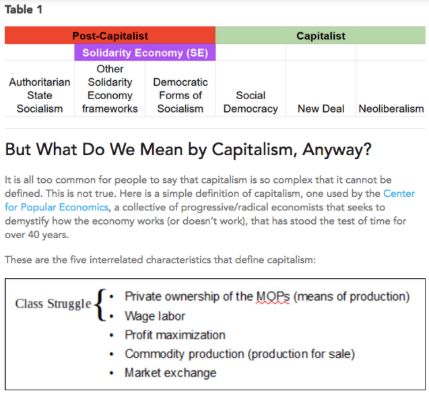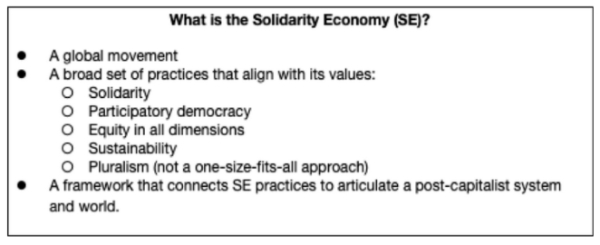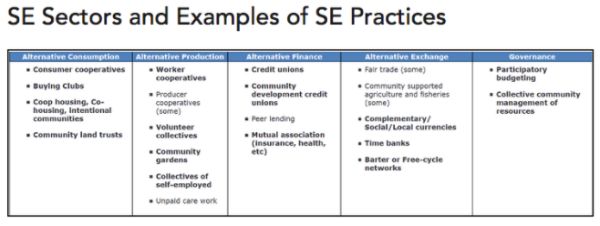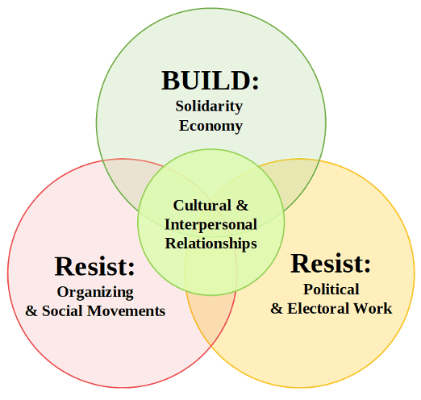System Change: A Basic Primer To The Solidarity Economy
Transferring ownership to workers, communities, and/or the state allows for a shift in the entire focus of the economy from generating profit for the top one percent to serving all the people.
by Emily Kawano, Julie Matthaei

The COVID-19 pandemic has upended our world. It has laid bare the inequity, the limits, and the failures of capitalism. The door to a better future beyond capitalism, already cracked open by the Great Recession, has been pushed open a little wider.
Things that seemed impossible a few months ago now seem both possible and necessary. This historic moment calls for us to push hard and through that door to build a world that centers people and planet. To do so, we need to be clear about what we’re trying to leave behind (capitalism) to have greater clarity about what it is that we’re moving towards (post-capitalism and solidarity economy).
Alternatives to capitalism are gaining adherents. Indeed, a recent Gallup poll found 43 percent of the respondents expressing support for socialism propelled by the candidacy of Bernie Sanders and his platform of democratic socialism.
And yet, there is a great deal of confusion about both what socialism and capitalism mean. Here we look at different systems or models of socialism, capitalism, and solidarity economy.
For those working for system change, clarity is imperative. In its absence, the default is likely to be to “reform” capitalism, without even considering the possibility of building an economy and world beyond it. We respect those who seek a just and sustainable world by reforming capitalism. We just disagree as to whether that is possible.
Table 1 provides a framework that distinguishes capitalism and post-capitalism. It identifies the main modern capitalist and post-capitalist economic systems, which we discuss below. Within post-capitalist systems, the solidarity economy, as detailed below, does not include undemocratic systems such as authoritarian state socialism.

One characteristic alone does not make an economy capitalist. For example, markets pre-date capitalism by thousands of years and can also exist in socialism. The same goes for commodity production—production for sale, rather than use.
The specificity of capitalism’s mode of production lies in its division between owners (capitalists) of the means of production (land, buildings, machinery, tools, etc.) and the workers who produce goods and services. Capitalists maximize profits in many ways, but often by squeezing the workers—and therein lies the class struggle. A worker-owned co-op may produce commodities for sale in the market, but it is not a capitalist enterprise because the workers are the owners, thereby eliminating the class divide.
There is, of course, much more that can be said about capitalism—about its tendency to concentrate wealth and power, to celebrate the pursuit of self-interest as a social virtue, about its tendencies toward crises, about its incessant drive for growth.
Further, note that this definition of capitalism focuses on class. But capitalist economies in the real world intersect with other forms of domination, producing and reproducing gender, race, and man/nature inequality and exploitation, as well as class.
Types of Capitalism
There isn’t just one capitalist system. Table 1 above identifies three models: neoliberalism, New Deal capitalism, and social democracy. These are positioned along a spectrum, where the right represents free market, small government, competitive forms of capitalism, and the left represents an active government that provides regulations and redistribution to protect people and planet, including feminist, anti-racist, and ecological principles and policies.
Neoliberalism, currently the dominant economic paradigm in the US and much of the world, broadly asserts a vision of government small enough to “drown in a bathtub,” as Grover Norquist put it. Of course, that is hardly likely to happen, but neoliberalism as an ideology has been used to promote austerity (i.e., reduced education, health, and social spending), pro-corporate regulation and privatization; shift taxes from the one percent to working people; and increase police and military spending (an item requiring a larger state). This is all done in the name of maintaining “free” markets, ignoring the fact that these markets are constructed by the state to favor owners of capital and are far from free.
Prior to neoliberalism, capitalism was dominated by New Deal capitalism (sometimes referred to as Keynesianism) in which government sought to build a social safety net, address market failures, regulate unscrupulous businesses, bust up monopolies, and at least nominally promote greater economic equality.
New Deal capitalism emerged from the utter failure of President Herbert Hoover’s policy approach to the Great Depression of 1929. Year after year the Depression deepened, until the Roosevelt administration began in 1933 to push through the New Deal (stolen from Eugene Debs and the Socialist Party), which, in addition to establishing social security, unemployment insurance, antitrust measures, union rights, and much more, created large-scale public programs such as the Works Progress Administration. These measures started to pull the economy out of the Depression, but it took the even more massive public spending of WWII to finally boost the economy back to full employment and rapid economic growth.
New Deal capitalism continued into the 1970s. However, billionaires and other conservative forces gradually undermined it. A paradigm shift occurred such that neoliberalism became the dominant discourse, and tax cuts for the wealthy (and, less spoken about, tax increases for working people) became the norm. In recent years, however, New Deal capitalism may be making a comeback, with many seeing Bernie Sanders’ presidential campaign in 2016 as initiating a snowballing movement back toward a New Deal-like paradigm.
Social democracy, as epitomized by Scandinavian economies, is a stronger and more generous version of New Deal capitalism (or perhaps Scandinavians would say that the New Deal was watered-down social democracy). While social democracy can serve as a transitional phase toward post-capitalism, it is still capitalist, as capitalist corporations continue to dominate the economic and political landscape.
It is important to note that whichever economic paradigm is dominant, there are always elements of other systems that exist. So, within neoliberal capitalism, there also can exist elements of pre-capitalism (e.g., human trafficking, which is a form of slavery) and post-capitalism (e.g., worker cooperatives).
What does “post-capitalism” look like?
Having defined capitalism, what then is post-capitalism? It literally means “after capitalism.” A post-capitalist framework holds that no matter how we “tame” or “humanize” capitalism, its fundamental logic precludes living in harmony with each other and nature. Capitalism’s development has been inextricably intertwined with racism and patriarchy and continues to exploit both. Capitalism’s drive to “accumulate or die” drives insatiable extraction from nature. Post-capitalism attempts to build upon capitalism’s achievements while transforming and transcending its obvious failures.
Authoritarian post-capitalism systems
Early post-capitalist experiments, such as the Soviet Union (1922-1991) and China (1949-1978), replaced feudal and emerging capitalist structures with centrally planned economies run by an elite Communist Party. We call this type of economy authoritarian state socialism. Peasants and workers gained basic economic rights, such as education, health care, housing, and the right to a job, but political and economic democracy was suppressed. Furthermore, these economies often reproduced patriarchal and racial inequality, and were often highly exploitative of nature.
Democratic post-capitalist systems and the Solidarity Economy
Solidarity economy (SE) is a post-capitalist framework that emerged in Latin America and Europe in the 1990s. It rejects state-dominated authoritarian forms of socialism, instead affirming a core commitment to participatory democracy. Furthermore, it is explicitly feminist, anti-racist, and ecological, and advocates for economic transformation that transcends all of forms of oppression, not just class.

SE is a big tent, embracing many coexisting visions—far too numerous to name here—of democratic post-capitalist economic systems. The SE framework for system change focuses on the process of building economic practices and institutions based on the values of equity in all dimensions (race, class, gender, sexuality, and so on), cooperation and solidarity, economic and political democracy, sustainability, and pluralism.
We do not need to “wait for the revolution” because SE practices already exist all around us today. Our task is to make these practices visible, and to grow and connect them. SE institutions include cooperatives (worker-owned, consumer, producer), public banks, community land trusts, alternative currencies, and time banks.

In contrast to the narrow self-interest, competition, and struggle to dominate others that are at the heart of racist, patriarchal capitalism, the solidarity economy is centered on a culture of solidarity, mutuality, caring, and cooperation, including social responsibility, economic human rights, and the rights of Mother Earth.
Is Bernie’s Platform Socialist?
Senator Bernie Sanders (I-VT) advocates for a greatly expanded public sector or public investment, to ensure that everyone has access to healthcare, higher education, and employment as well as to rein in climate change.
Is this socialism? In our view, it is not. Bernie articulates a partial vision of socialism but omits a central tenet: the need to transfer ownership of the means of production (land, buildings, tools, machinery, etc.) to workers, the community or the state.
For us, while an expanded public sector that delivers universal healthcare, higher education, jobs, and affordable housing are all laudable policies, they do not add up to socialism. This is social democracy. It is far better than neoliberal capitalism. However, it is still capitalist—privately owned corporations hold sway over those countries’ economies, politics and societies. Transferring ownership to workers, communities, and/or the state allows for a shift in the entire focus of the economy from generating profit for the top one percent to serving all the people.
Is System Change Unrealistic?
Many liberals and social democrats contend that progressives should abandon the goal of moving beyond capitalism. Capitalism, they argue, is here to stay.
We disagree. First, we believe the failures of capitalism—from blind growth to the corruption of governments around the world to the destruction of the climate—are becoming more and more evident. These failures are creating the grassroots energy needed to move beyond capitalism to something better.
Second, we believe struggles for reforms within the capitalist system are strengthened if New Deal capitalism and Social Democracy can be understood as transitional—part of a gradual struggle for system change, from capitalism towards post-capitalism. They help move us towards a better system, but they do not achieve it.
As Rosa Luxemburg famously argued in Reform or Revolution, reforms are necessary in the struggle for socialism, but without the goal of socialism, they represent only partial victories at best, and co-optation by the system at worst. Thus, we must be careful to present reforms that we are struggling for as part of a larger process of system change. This means always striving to situate all struggles for reforms within a larger, multi-pronged strategy for systemic transformation.
Another reason we insist on the system change framework is that it allows us to discuss the many connected ways in which this change must occur in ourselves and in the economy, so we can build a true culture of solidarity, and transcend racism and patriarchy. The system-change perspective allows us to locate any action that is anti-racist, feminist, ecological, anti-classist, and pro-worker as a necessary (but insufficient) part of an epochal global shift from capitalism to post-capitalism.
Finally, using the system-change framework—and highlighting the limitations of capitalism—is necessary for the liberation of women, people of color, and nature. Struggles against patriarchy and white supremacy tend to be narrowed into struggles for equality within capitalism—for example, efforts to create Black or women owned capitalist businesses. However, such struggles leave the majority of women and people of color still trapped in an economy and government run by and for the top one percent. So, for example, the election of Barack Obama did not eliminate black-white inequality in terms of incomes, poverty rates, or wealth. Indeed, the wealth disparity between blacks and whites actually increased during Obama’s tenure: whites’ median wealth rose from being seven times more than that of blacks to 10 times more!
Similarly, organizing to protect the environment without challenging capitalism’s profit motive and growth focus is bound to fail. Capitalism’s drive to “accumulate or die” destroys ecological balance and drives climate destruction.
The Way Forward
The solidarity economy vision of system change requires us to both “resist” and “build”—that is, resist all forms of oppression, and build SE values and culture, practices, and institutions. In order to transcend capitalism, four overlapping and interconnected spheres need to be involved: social movements; electoral politics; culture and interpersonal relationships; and solidarity economy institutions and practices.

The SE movement uses the metaphor of the butterfly to represent the transformation of racist patriarchal ecology-destroying capitalism into the solidarity economy. When a caterpillar makes its cocoon, it starts to form imaginal cells, each with the potential to become a part of the emergent butterfly. At the beginning, the caterpillar’s immune system perceives them as alien and kills them off. But as they find each other and clump together, they gain strength and together build a butterfly.
Given multiple crises, resistance is a natural tendency. Social movements try to keep the caterpillar alive and healthy, against great odds. The SE movement calls on us all to find each other and create a butterfly. None of us, and none of our organizations or movements, can build a new economy on our own. But together, with shared values and vision, we will.
Emily Kawano is a founder of the U.S. Solidarity Economy Network, served on the RIPESS Board for 8 years, and co-directs Wellspring Cooperative. She has a Ph.D in economics from UMass, Amherst where she joined the Center for Popular Economics and served as director for nine years.
Julie Matthaei is a Professor of Economics at Wellesley College, where she teaches courses on feminist economics and the political economy of gender, race, and class. She is a co-founder and board member of the U.S. Solidarity Economy Network. She is the author of the forthcoming book From Inequality to Solidarity: Co-Creating a New Economics for the Twenty-First Century.


 Australian Catholic University: Principals Navigate Growing Challenges As Anxiety, Depression Increase And Violence, Workloads Intensify
Australian Catholic University: Principals Navigate Growing Challenges As Anxiety, Depression Increase And Violence, Workloads Intensify SNAP: Survivors Deliver Vos Estis Lux Mundi Complaints Against Six Cardinals To Vatican Secretary Of State Parolin
SNAP: Survivors Deliver Vos Estis Lux Mundi Complaints Against Six Cardinals To Vatican Secretary Of State Parolin UNICEF Aotearoa NZ: Myanmar Earthquake A Further Blow For Millions Of Children
UNICEF Aotearoa NZ: Myanmar Earthquake A Further Blow For Millions Of Children Greenpeace: 'Desperate And Deceitful'- Deep Sea Mining Frontrunner Turns Its Back On Pacific Nations
Greenpeace: 'Desperate And Deceitful'- Deep Sea Mining Frontrunner Turns Its Back On Pacific Nations 350.org: Australia Announces Election Dates, Pacific Islanders Rally To Vote For Climate
350.org: Australia Announces Election Dates, Pacific Islanders Rally To Vote For Climate UNICEF Aotearoa NZ: Global Aid Funding Cuts - 14 Million Children At Increased Risk Of Severe Malnutrition And Death
UNICEF Aotearoa NZ: Global Aid Funding Cuts - 14 Million Children At Increased Risk Of Severe Malnutrition And Death